Kuruma Ningyo Performance and Books
In 2019 and 2020 I worked on translating two picture books from Japanese to English for the town of Miyoshi Town in Saitama--one about heritage sweet potato cultivation, and the other about the revival of Chikumazawa Kuruma Ningyo Puppetry.
Kuruma Ningyo puppetry was developed in the early Meiji Era (1868-1912). The last documented performance in the Miyoshi Town area was in 1921, and the art was then gradually forgotten. Then, in 1971, a storage area in an old house revealed multiple wicker baskets containing various puppet pieces, costumes, and the wooden rolling carts that puppet operators sit on.
Fortunately, a couple elder puppeteers were still living and able to teach a few members of the community how to assemble and manipulate the puppets, and those new puppeteers, in turn, taught others, and soon the Kuruma Ningyo Preservation Society was born. Now local schools feature programs on Kuruma Ningyo puppetry, with the hope that this art form, now designated an Important Tangible Cultural Property in Japan, will continue to be practiced by and performed for generations to come.
The puppetry book, titled かえてきた竹間沢車人形 (Kaettekita Chikumazawa Kuruma Ningyō) written and illustrated by Noriko Sagesaka, was translated by me as The Puppets are Back! Chikumazawa Kuruma Ningyo Puppetry. As I was working on the text translation, I had a chance to see a lecture and mini perfomance, learn about and try manipulating the puppets and the cart the puppeteer sits on, but I especially looked forward to seeing a fully staged production. But coronavirus intervened, and public performances of the growing puppetry troupe were halted.
Now, at last, performances are back on, and recently I was lucky travel up to Miyoshi Town to attend the first major public performance in three years at the Bunkakaikan. Kuruma Ningyo dramas are built on Buddhist setsuwa and this performance was the tragic love story of the monk Anchin and Kiyohime, the young woman he rejects; once spurned by Anton, she turns herself into a dragon and kills him in the temple bell in which he'd hidden. Here are a few photos taken after the performance:
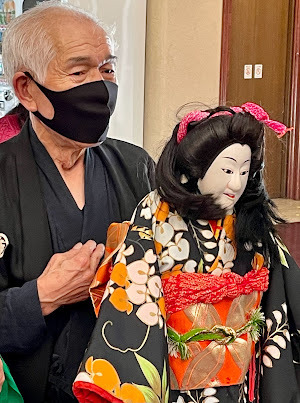
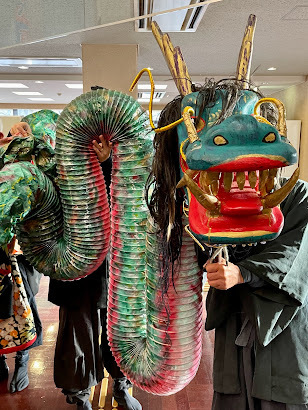
 Here you can see the roller cart (upside down) that the puppeteers sit on.
Here you can see the roller cart (upside down) that the puppeteers sit on. 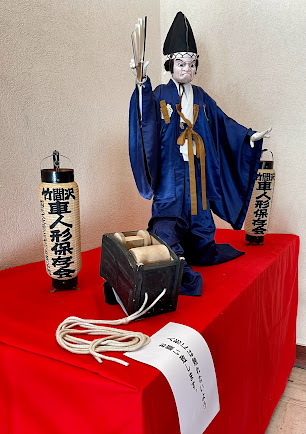 And it was fun to meet again the puppeteer who was the young girl in the picture book story.
And it was fun to meet again the puppeteer who was the young girl in the picture book story.
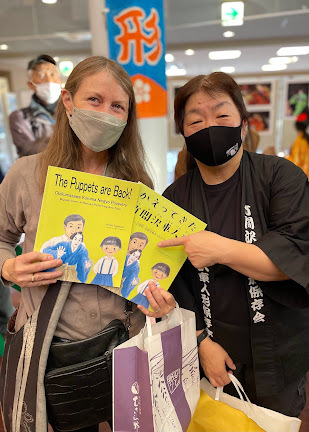 And the performance space was the performance space featured in the picture book.
And the performance space was the performance space featured in the picture book.
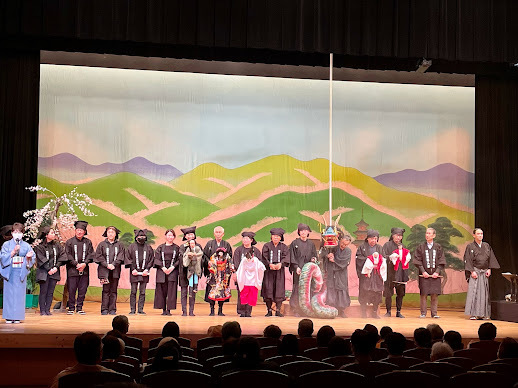

 And a bonus was sitting and chatting with Tomoko Shirota, my patient editor for the two Miyoshi Machi books, together with, just coincidentally, the Fukuinkan Shoten editor of two picture books I'd just recently translated : )
And a bonus was sitting and chatting with Tomoko Shirota, my patient editor for the two Miyoshi Machi books, together with, just coincidentally, the Fukuinkan Shoten editor of two picture books I'd just recently translated : )



